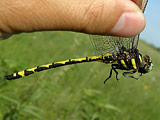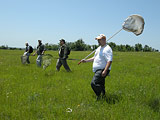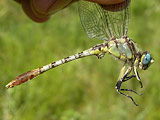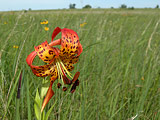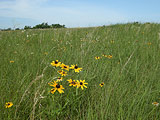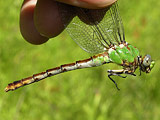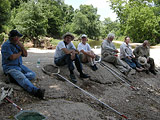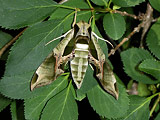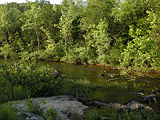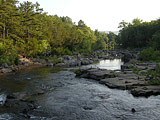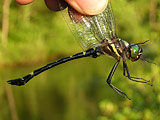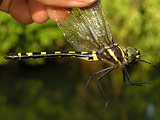
Dragonfly Society of the Americas Annual Meeting
June 19-21, 2009, Sullivan, Missouri
& pre-meeting and post-meeting excursions
Tuesday, June 16: There were two pre-meeting trip options available before the DSA annual meeting in Sullivan, Missouri. One was based in the town of Columbia, a couple hours west of St. Louis where I would be landing. The other was in the far southwestern corner of the State in Lamar, a good 6 hour drive from St. Louis. Guess which one I chose.
There were actually more species I needed on the Columbia trip list versus the list for Lamar, but most of those we could encounter during the meeting itself. Still up to a couple of days before getting on the plane (from New York to Atlanta to St Louis) I hadn't made up my mind which one to attend. But on the DSA webpage for the meeting there was a scan of an odd spiketail. Maybe a new species or just a prairie variation of an Arrowhead Spiketail, Cordulegaster obliqua. Instead of small yellow arrowheads on top of the abdomen it had large rectangular markings. Being a sucker for pictures, I just had to see this one despite one grueling travel day. When I arrived at the motel in Lamar, Tim Vogt had a living pair waiting, having caught them a couple of days previously.
Wednesday, June 17: Led by Tim, we were a small group: Nick and Ailsa Donnelly, Mike Blust, Bryan Pfeiffer, Erik Pilgrim, and myself. We looked for more Cordulegasters, following a small stream along the edge of Prairie State Park. A few Regal Fritillary butterflies floated on the breeze. Bryan caught a young male spiketail, and later a female was caught. We came to a pond, where some common skimmers were flying, mostly Spangled, Libellula cyanea and Widow Skimmers, Libellula luctuosa. We found a handful of male Stillwater Clubtails, Arigomphus lentulus perching along the pond edges. No females were seen, the first of many targets missed.
Our next stop was a parcel of prairie called Cook Meadows. In the rising heat we found another spiketail, which Bryan and Mike photographed. It was likely the first time this particular form had been photographed in the field. After they were done I moved in with the net but it had enough of posing and took off before I was ready to swing.
We tried a couple of more spots and saw a few more species like Comet Darner, Anax longipes and Mocha Emerald, Somatochlora linearis. I got to step onto Kansas soil for the first time. At the end of the day we stopped to turn the cars around to head back to Lamar when we noticed a few dragonflies flying around. We managed to net a few which turned out to be Slender Baskettails, Epitheca costalis. We saw another Comet Darner, then a River Cruiser, Macromia of some sort. Tim netted a Sulphur-tipped Clubtail, Gomphus militaris that just happened to fly by, the only one I saw on the trip. I spotted a Black-shouldered Spinyleg, Dromogomphus spinosus, and Bryan braved poison ivy to reach for a Banded Pennant, Celithemis fasciata. It was a pleasant way to end the day, unexpected variety on a random stretch of road.
Thursday, June 18: Our plan was to revisit Cook Meadows in the morning for more spiketails. Tim needed more individuals for DNA work on them. Then we would head three hours east, stop at a fen in Mark Twain National Forest before heading to the meeting in Sullivan.
I spotted a spiketail the moment I reached the stream. I followed until it landed and netted it. A little ways down the stream I caught another male gaining a little redemption for missing the one the day before. Later I spotted a third, but it had just emerged and was very teneral. Although it would have been just as useful for DNA, I decided to let it go unmolested. Tim caught another female so three from the site should be sufficient.
Then we convoyed east arriving at Kaintuck Hollow in mid-afternoon. Tim warned us there might be biting flies in the fen but they weren't bad at all. But it was hot and coupled with the humidity in the fen it was hard not to just stand in the shade. There weren't many species found, Gray Petaltail, Tachopteryx thoreyi and Seepage Dancer, Argia bipunctulata were the most common. There were handful of skimmers and a few Springwater Dancers, Argia plana of the blue variety. I was hoping to find clubtails so I worked the dryer ground and I found a single female Westfall's Snaketail, Ophiogomphus westfalli. I had collected only a male of the species a couple of years ago in Arkansas so this was on my list and a fortunate find.
Friday, June 19: Field trips began at 8AM heading mostly for the Meramec and Bourbeuse Rivers. The organizers provided quite a list of species for the two rivers but nothing was guaranteed. I was particularly interested in the pond clubtails, Arigomphus for which I need females, a couple rare for the region clubtails, Gomphus, and Gilded River Cruiser, Macromia pacifica.
I joined the Bourbeuse River group led by Jane Walker and Joe Smentowski. The first clubtail we found was a Common Sanddragon, Progomphus obscurus. Further down river we started seeing a clubtail with lots of yellow on the abdomen which turned out to be Pronghorn Clubtail, Gomphus graslinellus. We also picked up Ozark Clubtail, Gomphus ozarkensis a large dull colored species and the tiny Interior Least Clubtail, Stylogomphus sigmastylus. I saw a River Cruiser. It did not have a lot of yellow on the abdomen so it probably was a Swift River Cruiser, Macromia illinoiensis. As the group scattered up and down the stream, Joe was trying hard to keep tabs on everyone's whereabouts during the stop. I was told he was a retired science teacher and he sure seemed to be treating us like students on a field trip. I was amused at first but after a little while it got annoying.
We tried a couple of crossings further downstream but the river was swollen and difficult to access. We returned to a spot upstream that looked good when we stumbled upon it earlier, and spent the rest of the afternoon there. We found a couple of male Westfall's Snaketails, and late in the day I caught a male Rapids Clubtail, Gomphus quadricolor but I did not get or see anything on my list.
Saturday, June 20: The business meeting indoors. The talks were fine although I was nodding off a bit in the warm room. It's usually tempting to skip out on the slide shows but the meager results of the day before were not encouraging. Rain, swollen rivers, now heat. I've been here before.
The arranged buffet banquet in the town of Cuba was pleasant enough. I ate plenty. Near the end Joe stood up and reminded everyone to gas up before we went on the next day's field trips because on the previous day we irked him by stopping for gas along the way to the Bourbeuse. (Helps if the leader tells us beforehand how far we had to go). Dennis Paulson stood up and asked if we should all go to the bathroom first, getting a good laugh from the room.
Sunday, June 21: Two trips were planned. One to see Hine's Emerald, Somatochlora hineana and a second trip back to Kaintuck Hollow fen. If I wasn't working on the book I probably would have tried to see the emerald, a species I have not seen. But being listed as a federally endangered species (which research has shown it shouldn't be) there wouldn't be any netting and I'm not equipped for field photography. It also threatened to resemble another school field trip. But I weighed the certainty of seeing the emerald versus the shrinking possibility of finding something I needed at Kaintuck. It would be earlier in the day than my last visit to the fen so maybe there might be something different.
There were a few more species found. The most intriguing was a female emerald that we waited for but could not relocate. After driving around a bit we located a couple of ponds. I was hoping for females of Comet Darner, Spatterdock Darner, Rhionaeschna mutata and Unicorn Clubtail, Arigomphus villosipes. We saw males of all these species. I saw what I think was a female Unicorn Clubtail perched along the creek but watched it disappear winging down the stream.
I said my goodbyes to the group and headed southeast to spend the night in the town of Farmington. Tim Vogt recommended a site in Madison Co. for Gilded River Cruiser and both he and Ken Tennessen encouraged me to get to the creek early in the morning. So far I had only gotten the odd spiketails and the female Westfall's Snaketail so I felt like I needed the river cruiser to make my trip a success.
Monday, June 22: At was at Marble Creek in the Mark Twain National Forest at 7AM and saw river cruisers flying along the stream above a dam. The water was deep on the parking lot side of the creek so I couldn't wade in. I perched myself on the rock and tried to catch the dragonflies as they came by. They flew a fairly consistent path, coming down along my side of the stream until they came to some overhanging branches then crossed to the far side. Still they were at the edge of the range of my swing and when I finally got the net on one I knocked it into the water. I tried to scoop it out but the current carried it away from me. As I watched in frustration, a fish rose and pulled the dragonfly under.
Annoyed at the overhanging branch I thought I could possibly pull it closer to shore and perhaps the cruisers would alter their path to follow along. There was a submerged rock that I thought I could step on but it turned out all the large stones were as slippery as ice. With the wrong shoes I slid off the rock and found myself chest deep in water. Well that didn't work. At least my camera was sitting dry on the bank.
I needed to get to the other side of the stream and I finally thought to cross at the top of the dam. On the far side the sun was better, the water shallower and gravel bottomed. I had a few better swings but the cruisers were noticeably faster now that they had warmed up. My right handed swing would often make me swing at them from the front and they evaded me with ease. By 7:45 they were gone.
I tried along the shoreline and flushed up some Orange Shadowdragons, Neurocordulia xanthosoma. I followed a powerline cut up to some fields but didn't find where the cruisers were hiding. The temperature rose to the high 90's. I took a nap, then tried again in the afternoon hoping the cruisers would fly again. I outlasted a number of bathers seeking relief from the heat and had the stream all to myself at 7PM. The sun dipped below the trees and I headed back to the motel without seeing any more river cruisers.
Tuesday, June 23: With my flight scheduled to leave at 1:30PM, the morning would be my last chance to get Gilded River Cruiser. I got up at 3:45AM, was on the road at 4:30 and arrived at the stream an hour later. Although the sun would not rise for another 10 minutes I saw some river cruisers. Flying with them were a couple of Dragonhunters, Hagenius brevistylus and an Orange Shadowdragon or two. I quickly crossed the dam and found a good rock that they cruisers seemed to fly consistently close to. I pancaked my net onto one going by. Fishing it out of the wet net, I was surprised to find it was an Illinois River Cruiser. But I had clearly seen dragonflies with more yellow on the abdomen so I got back on the rock and waited for the next one.
The wet net landed with a plop and this time it was a male Gilded. I felt more relieved than anything else as I held him by the wings. The next catch was another Gilded. I had to look twice to confirm that it was a female. Now I was ecstatic. Getting females would be tough I was told. It wasn't yet 6AM and I had a pair. I saw several more. One time I saw three Gilded River Cruisers come together to chase each other. But I didn't manage to catch any more. They flew faster as the sun hit the stream and by 6:45 they were gone again.
Two and a half hours to St. Louis. Return the rental car, ride the bus to the terminal. Flight to Cincinnati, flight to La Guardia, bus to train, train to home. Wife in the car, hug the boys. Scan the cruisers. Go to bed.
